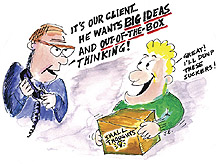|
Becoming strategic partners in the 1990s
Three blue-chip marketers list the top 5 things
each wants most from agencies
By John Emmerling
Advertising Age
June 8, 1998
 During the’70s, savvy advertising agency CEOs lunched regularly with client CEOs. Talented agency staffers worked side by side with marketers, jointly developing brand-building strategies. During the’70s, savvy advertising agency CEOs lunched regularly with client CEOs. Talented agency staffers worked side by side with marketers, jointly developing brand-building strategies.
Then the 15% commission system began to wither away—and, as their margins shriveled, ad agencies couldn’t compete with other industries that began to pick of the best and brightest of college grads.
One result: The agency’s strategic thinking role diminished. In many cases, shops became mere vendors of creative product. ("Yes, sir… two ads and a commercial. Would you like fries with that?")
RETURN TO GLORY?
Is all this about to be reversed? Can agencies return to the glories of yesteryear—and be as good as we’ve ever been?
At the wrap-up session of the American Association of Advertising Agencies annual meeting this spring, major advertisers with gigantic budgets urged agencies to become their long-term strategic partners.
From the podium, Robert Wehling, head of advertising at Procter & Gamble Co., challenged agencies to "focus as many people as possible on the creation of big ideas that will drive a brand’s business for years and years and years."
Patrick McGinnis, CEO of Ralston Purina Co., told his audience of agency executives: "The resource your organizations have that we don’t is your tremendous creativity. Agencies need to step out of the box and add value to the strategic process."
What are major clients demanding—right now—from their ad agencies?
To get a few answers, I recently called Phil, Abby and Pete. With each call, I asked these mega-clients to list their "Big Five"—the things they wanted most from their agencies.
WHAT GM WANTS
Here’s Phil Guarascio, head of advertising at General Motors Corp.—"First I have to tell you, John," he barked, "that I don’t sit around writing out lists." But then, warming to the topic, he outlined the five things he wants most from GM’s agencies.
- Brilliant planning and strategy;
- More emphasis on ideation during strategic development;
- Highly talented people on his business;
- Much more accountability by agencies; and
- More risk taking.
"You get unique insights," said Phil, "from brilliant people who really understand what the consumer wants." He pointed out that different people—looking at exactly the same data—can come up with very different conclusions. One thing is for sure: The best insights invariably come from the best minds.
Phil sees marketing challenges this way: "We’re moving from push marketing to a pull marketing architecture—and that means a higher level of consumer control."
Only an ad agency, he explained, is equipped with three critical ingredients: Agencies understand the consumer; they know the channels through which to reach the consumer; and they have the unique ability to construct a message.
As push moves to pull, he said, "I expect our agencies to help us understand how to make better connections with the consumer."
IBM’S CHECKLIST
Next up is Abby Kohnstamm, who heads corporate advertising at IBM Corp. With her agencies, she is looking for "the opposite extreme from a vendor relationship."
Here’s Abby’s Big Five list, what she expects IBM agencies to deliver.
- Be a true strategic marketing partner;
- Demonstrate creativity and innovation—in positioning ideas, strategy development, media approaches and in the actual advertising product;
- Use the full set of options in the marketing mix—blending advertising, direct marketing, interactive marketing and event marketing;
- Attract, retain and motivate really top talent; and
- Tailor the right type of solutions to the resources available. ("Don’t build me a yacht if what I need is a fast canoe.")
Abby feels strongly about the type of people who should work on the IBM business. She wants people with "a kind of competitive spirit" who—instead of being reactive—will anticipate an opportunity and aggressively go after it.
"The best account people read something in the papers Sunday morning," she said, "and call me up Sunday afternoon to say ‘I had this idea…’ "
BRISTOL-MYERS’ BIG FIVE
Pete Spengler is cleanup batter on this championship squad. Pete, who runs advertising at Bristol-Myers Squibb Co., outlines this Big Five list of requirements for agencies:
- Great breakthrough advertising;
- Recruit to the agency the kind of top-flight people who are too often lost to other industries;
- Assign senior people with deep knowledge of our business;
- Be more of a functional partner; and
- Deliver one-stop shopping. ("Offer us multiple services so we can integrate our efforts better.")
And what about those "top people" that so many clients seem to want? Pete sees it this way: "Everybody’s cutting back on their expenses. The agency would love to go out and hire top-flight talent. But who’s going to pay for it?" He suggests clients look seriously at their agency’s fee structure to make sure it’s adequate. "As a client, you’d better deal with the agency’s concern for making a fair return on their investment."
THE PAYOFF
So here’s the payoff to us in the ad agency business: This can be an exciting new era. Clients are inviting us back to the strategic table—and telling us to bring our creative firepower.
Agencies everywhere should rejoice, eagerly joining with their clients as long-term strategic partners. Agencies should enthusiastically meet the client’s challenge to deliver "out-of-the-box" insights and ideas—and then be accountable for the results.
But remember (as Pete indicated), clients may need to address new agency compensation models. Because in our business, "out-of-the-box" thinkers are expensive.
And there’s no free box lunch.
back to top | more columns »
|





